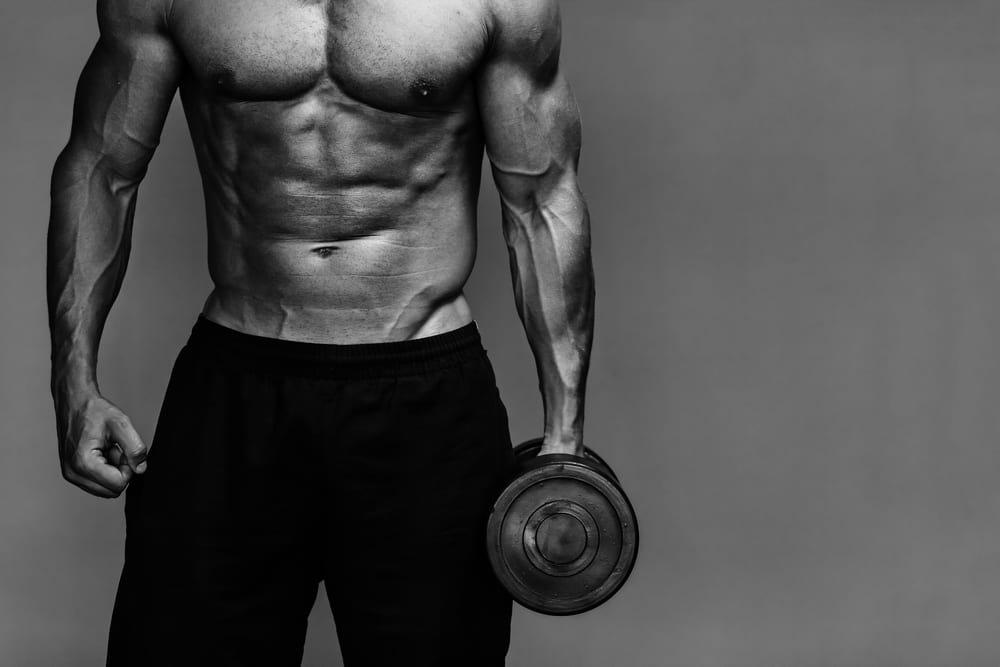Are you struggling to pack on size?
Does it seem like you’ve tried everything, yet nothing you do seems to work?
If so, you’re not alone. Every day, millions of dudes across the world venture to the gym with the goal of getting huge, yet many fail.
Type “how to build muscle” into a Google search, and you’ll get more than 4 million results!
With so much information out there, it’s no wonder you’re confused.
You can build muscle a number of different ways, but there are certainly plenty of things you can do to completely kill your gains.
What are they?
Check out these five muscle-killing mistakes you may be making.
1. Trying to bulk when you’re not already lean
Unless you want to add a bunch of fat, you have no business entering a bulking phase if your body fat isn’t already around 10 or 12 percent.
 You need to focus on getting lean first.
You need to focus on getting lean first.
Decreasing body fat percentage increases testosterone levels and increases insulin sensitivity.
If you have a body fat percentage that’s too high (i.e. you don’t have visible abs), you won’t be able to use insulin efficiently. Many experts believe fat around the waist is a major cause of insulin resistance, a condition in which your muscle, liver and fat cells won’t be able to absorb glucose from the bloodstream (Insulin Resistance and Diabetes).
Since your body doesn’t use the anabolic hormone insulin well, you’re not going to be able to shuttle nutrients into your muscles. You’re going to pack on a lot more fat than muscle if you’re insulin resistant.
Not good.
Increased fat mass is associated with lower levels of free testosterone and growth hormone too (Vermeulen et al., 1999). Your levels will go back to normal, though, if you decrease your body fat.
Do a quick check – can you see at least an outline of your abs?
If you can’t, you need to reduce your body fat by staying in a slight caloric deficit. To calculate how many calories you need, check out the formula in the next section.
If you’re lean enough to bulk, make sure you do a clean bulk.
Eat just enough to allow you to slowly gain muscle.
If you try the old-school dirty bulk and eat everything in sight, you’re going to put on more fat than muscle and look like a slob!
2. Ignoring the energy balance equation
“What supplements should I take?”
“What should I eat post-workout?”
“How much protein should I eat to build muscle?”
While all these questions have their place, they aren’t the most important things to focus on in a muscle-building program.
Hitting your calorie requirements and macronutrient goals for the day are the big-ticket items that should be the majority of your focus.
Ultimately, it doesn’t matter how many calories you take in post-workout if you don’t meet your calorie needs for the day.
Let’s say you need 2,800 calories per day to put you in a slight caloric surplus to gain weight and build muscle. You focus all your efforts on the exact formula necessary to take advantage of the post-workout anabolic window, eating 100 grams of carbohydrate and 25 grams of protein for a perfect 500-calorie post-workout meal.
However, you focus so much on that post-workout meal that you take in only 1,000 calories the rest of the day. That means you’re 1,300 calories under your daily total. Your muscles aren’t going to grow if you’re in that big of a caloric deficit.
To gain weight, you’ve got to be in a positive energy balance, taking in more calories via food and liquids than you expend via exercise and other activity.
To lose weight, you’ve got to be in a negative energy balance, expending more calories than you consume.
If you want to put on some size, figure out your calorie requirements first. Let’s use the Mifflin equation.
For Men: Resting Metabolic Rate (in calories/day) = 10 (weight in kilograms) + 6.25 (height in centimeters) – 5 (age in years) + 5
For Women: RMR (in calories/day) = 10 (weight in kilograms) + 6.25 (height in centimeters) – 5 (age in years) – 161
Let’s say you’re a 20-year-old guy who’s 6 feet tall and weighs 160 pounds. To figure out your weight in kilograms, divide 160 by 2.2, which is approximately 72.6
Six feet in centimeters is 182.88.
Let’s plug in the numbers:
RMR = 10 (72.57) + 6.25 (182.88) – 5 (20) + 5
RMR = 725.7 + 1,143 – 100 + 5
RMR = 1,773.7
So you need 1,773.7 calories to maintain your body weight at rest. That’s assuming you’re not moving during the day. Here’s how to factor in your activity level.
Sedentary (little or no activity) = RMR x 1.2
Mild activity level (intense exercise 1-3 times per week) = RMR x 1.3
Moderate activity level (intense exercise 3-4 times per week) = RMR x 1.5
Heavy activity level (intense exercise 5-7 times per week) = RMR x 1.7
Extreme activity level (intense exercise multiple times per day) = RMR x 1.9
Let’s say you exercise four days per week. Multiply 1,773.7 by 1.5, and you get 2,660.55.
But once again, that’s just to maintain your body weight. If you want to add about one pound per week, add 500 calories to that total.
So that’s about 3,160 calories per day. If you’re a 20-year-old male who’s six feet tall and 160 pounds, you’ve got to take in 3,160 calories per day to gain one pound per week if you’re exercising four days per week.
Keep that caloric intake and activity level consistent, and you’ll no doubt put on some size. Then, working on hitting your macronutrient goals. According to Precision Nutrition, your split should be as follows:
-
If you’re an ectomorph (naturally thin), consume 25% of your calories from protein, 55% from carbohydrate and 20%from fat.
-
If you’re a mesomorph (naturally lean and muscular), take in 30% of your calories from protein, 40% from carbohydrate and 30% from fat.
-
If you’re an endomorph (naturally thick), consume 35% of your calories from protein, 25% from carbohydrate and 40% from fat. (Berardi and Andrews, 2015)
Like we talked about – make sure you’re not in too big of a caloric surplus and be sure before you start to bulk you’re already lean. Otherwise, you’ll put on quite a bit of fat too.
3. Changing your approach too often
In the age of the internet, you can find information on building muscle just about anywhere. Easy access to information has its perks, but has its drawbacks too.
Why’s that?
Because there’s so much information out there, it’s easy to fall into the trap of constantly changing your routine every time you read something new.
One week you start to use intermittent fasting because some expert told you he put on muscle that way. Then, the next week you read a blog post in which the author argues you must eat breakfast every day because that’s what every bodybuilder does.

So who’s right?
Both approaches probably work – they just need to be followed out in full.
Just about every person who’s made a major body transformation has stuck to a plan for a long period of time.
By minimizing the number of variables you change, you’ll have a much better idea if what you’re doing is working.
If you start by training four days per week and taking in 3,000 calories per day with the intent of gaining weight, but then decide after a few days you need to add in some cardio and stop eating as much because your abs aren’t showing any more, you’re going to end up right back where you started.
Pick a plan, and stick with it. That’s why it’s important to choose only one focus at a time. If you’re bulking, focus both your training and nutrition on adding mass. If you’re cutting, focus both your training and nutrition on burning fat.
Research shows the best way to make gains is by creating small wins for ourselves.
According to a former professor from Stanford, the greatest way for people to improve is through making small changes in things we do often.
Instead of trying to follow some complex 3,200-calorie diet plan you’re going to follow for three days, focus on adding one nutrition habit at a time.
If you have trouble getting food in right away in the morning, have a protein shake every single morning. Toss some protein powder, oats, peanut butter, berries and spinach in a blender, and you’ll be able to add several hundred calories to your diet every day.
As we discussed before, the key to weight gain is staying is taking in more calories than you burn off, so start crushing those shakes!
Once you master this habit, add another. You’ll see much better results making small changes and sticking with them over a long period of time rather than making huge changes you can’t stick with for any amount of time.
4. Not tracking your progress
Take a look around just about any gym, and you’ll notice almost no one has any method of recording their workouts.
Well, honestly, most of these people probably don’t even have a workout plan to begin with, but that’s a topic for another day!
If you’re not tracking your results, you’re going to have no idea if what you’re doing is even working.
Progressive overload is among the most important factors in muscle growth because of general adaptation syndrome (Rosenblatt, 247).
Originally described by Austrian-born physician Hans Selye, general adaptation syndrome describes the body’s response to stress. In the alarm phase, the body reacts to a stressor by switching to “fight-or-flight” mode as it prepares to defend itself. Then, in the resistance phase, the body adapts to the stressor.
You need to challenge your muscles more each workout if you want to grow. Always aim to add weight to the bar or increase the tension you place on your muscles so they adapt and grow back bigger and stronger.
Keep a workout journal so you make sure you’re always increasing the challenge every workout.
You have literally no excuse not to track your workouts. You can buy a notebook for $1 at your local Wal-Mart. Otherwise, you can probably download a free tracking app on your phone.
If you want to pack on size, you’ve also got to take measurements consistently under the same conditions.
Weigh yourself naked every morning when you wake up, after you’ve gone to the bathroom and before you’ve had any food or liquids. Then, record your weight on a sheet of paper next to your scale. Take progress photos at the same time and day every single week.
If you measure everything under the same conditions, you’ll know it’s an accurate representation of your progress. That way, you won’t have to factor in whether you wore shoes last time or whether you just scarfed down a huge meal.
Tracking your nutrition is huge too. It may suck initially to have to record everything you eat, but you’ve got to know how many calories you’re consuming if you want your muscles to grow.
Use an app on your phone like MyFitnessPal to record your food intake. Many apps even allow you to scan a barcode on a package and the information automatically comes up.
5. Not taking the time to learn proper form
In today’s technologically advanced society, you have no excuse to not know proper form.
You can find videos and articles all over the internet giving you detailed descriptions of exercise technique.
If you fail to perform the lifts correctly, you’re receiving literally no benefits from a workout. You can have every other aspect of your program – like sets, reps, volume and intensity – planned perfectly, but if you aren’t executing the lifts well, you’re not going to see any gains.
Good technique allows you to take advantage of the three most important factors in muscle growth:
-
Mechanical tension
Your body doesn’t know the difference between a 20-pound dumbbell and a 50-pound dumbbell, but it does know the amount of tension it feels. If you’re trying to curl a 50-pound dumbbell, but you’re jerking your body around like a fool, you’re placing literally no tension on your biceps. Stick with a lighter weight and focus on feeling the muscle actually working.
-
Muscle damage
Delayed-onset muscle soreness (DOMS) is a phenomenon caused by micro-tears to your muscle tissue. In response, your body releases growth factors important for muscle growth. So being sore after a workout can sometimes actually be a good thing – if you’re training intelligently. Just make sure you’re not destroying yourself every time you’re in the gym.
-
Metabolic stress
Believe it or not, getting a “pump” can actually be a good thing for building some size. It’s not just folklore! The buildup of metabolic by-products in your muscles can lead to the release of anabolic hormones through cell swelling. Doing some burn-out sets every once in a while – as long as you maintain tension on your muscles – can put some serious size on your body.
Understand what kind of learner you are. Do you learn best by watching, by doing or by reading about something?
Knowing this information will help you determine if you should learn technique from watching videos, having someone teach you in person or reading a book or blog post.

About The Author
 Luke Briggs builds training and nutrition programs for guys who struggle to build muscle so they can be that ripped, muscular dude everyone wants to be.
Luke Briggs builds training and nutrition programs for guys who struggle to build muscle so they can be that ripped, muscular dude everyone wants to be.
You can check out Luke at:
Website: Luke Briggs Fitness
Facebook: LukeBriggsFitness
Twitter: @LukeBriggsFitness







